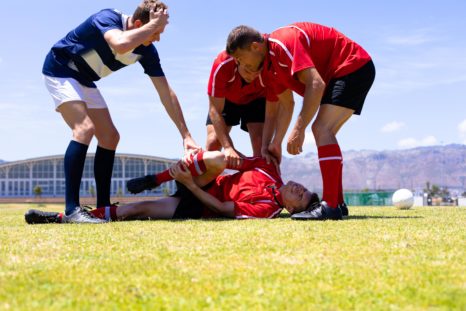Increase in Rugby Injuries Forcing Players into Early Retirement
Simon Moyes discusses how the recent increase in rugby injuries forcing players into early retirement.
Rugby is a fast-moving and high intensity team sport that has the highest risk per player/hour of injury of all sports. As many as one in four rugby players will be injured during the season, with approximately half of all injuries occurring while a player is tackling or being tackled.

Rugby injuries are not just becoming more common but they are becoming more serious, with more concussions being recorded. The consequences of these injuries are evident from the number of players who are being forced to retire early.
As injury rates rise, so does the risk of players accumulating multiple micro-injuries, which can pre-dispose the players to early osteoarthritis of various joints. Repeated concussion-related head traumas as well as physical damage to their joints can debilitate them for life. Managers and players should therefore think further than just the win at the end of the game.
We have seen an increase in incidences of severe shoulder injuries, knee injuries and ankle injuries, and this is something I have seen a great deal of amongst the doctors and physiotherapists that I work closely with.
The main reasons behind the injuries in the game are that rugby players themselves are becoming more professional and their training is becoming more elite. Their focus is to sustain a “sleep, train, eat” mode. As the players get bigger, stronger and faster, when they collide there is more power and kinetic energy behind these collisions and hence such collisions are more likely to produce injuries.
Certain “tricks” are also being used by players as they are coming into a collision which can make the opponents’ potential injury from such collision worse. Typical examples of this would be pushing down on top of the back of an opponent’s shoulder as he is coming in for a tackle which would make the shoulder more likely to dislocate or the tendon tear.
The players, managers, doctors and physiotherapists involved in looking after the players are all very aware of the risks of this high impact game. A general “straw poll view” of the potential ways for reducing injury rates is to somehow try and improve the skill of the players and techniques to avoid such injuries although this is clearly difficult. The only other line would be for the referees to be more alert to some of the tricks used to exacerbate injuries.
Simon Moyes is an internationally renowned orthopaedic surgeon and leader in the field of arthroscopic (keyhole) surgery. His Capital Orthopaedics team works from The Cromwell Hospital in London, with its state-of-the-art diagnostic and surgical equipment, and top sports medicine professionals.
